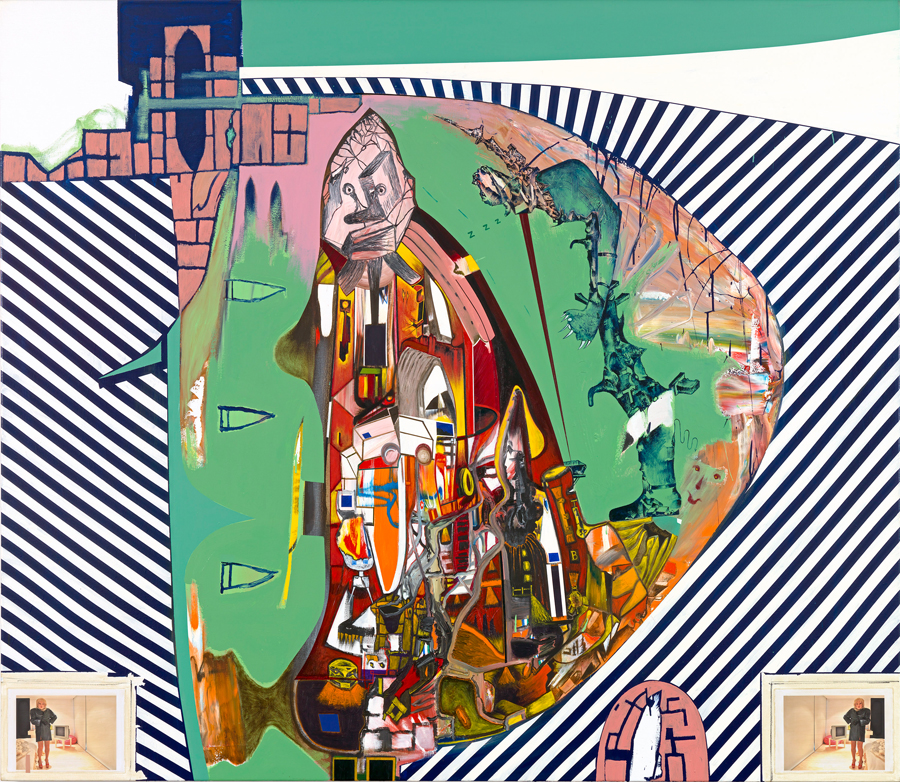Gareth Sansom
National Gallery of Victoria, Melbourne, Australia
National Gallery of Victoria, Melbourne, Australia

Curated by Simon Maidment, ‘Gareth Sansom: Transformer’ is the Australian artist’s most extensive survey to date: some 130 works, encompassing more than 50 paintings, a tapestry, works on paper, photography and miscellany culled from Sansom’s vast personal collection, which provides an insight into his studio practice. He held his first solo exhibition in 1959, although the earliest included works are from his third show in 1964. Maidment titled the exhibition after one of the artist’s more recent paintings, Transformer (2016–17), which incorporates images of Lou Reed’s eponymous second studio album from 1972.
Spanning seven gallery spaces, the works are broadly grouped around the themes that have preoccupied Sansom throughout his career: religion, sexuality, isolation and mortality. The artist’s use of enamel paint and strident colours (notably pink and orange) is echoed in the exhibition design by Cherie Schweitzer, who devised several walls in corresponding shades; some works are hung in recessed alcoves of red velvet.

In the 1960s, Francis Bacon and Jean Dubuffet’s approach to figuration inspired the young Australian artist and gave him the confidence to buck the conservatism of the local art scene at the time. In One of Us Must Know (1966), a found image of Bacon appears above a photograph of Sansom aged 26; he met Bacon the following year at the French House in London’s Soho. Sansom seldom refers to current events in his paintings but, following his return to Melbourne, he produced the sinister and contorted Wee Ian (1967–68), a reference to his almost-contemporary Ian Brady, the ‘Moors Murderer’, whose trial had convulsed the UK and reverberated as far as Australia. A newspaper article about the case is placed at the centre of the work against a predominantly red background, turbulent swirls of paint and agitated brushwork. Two further images from a medical textbook of patients with skin disorders contrast with the clean-cut image of Brady. The stylistic flourishes of British pop art can be seen with the inclusion of three hearts of the kind a teenage girl might draw – perhaps a reference to Brady’s first victim.
Throughout the 1970s and ’80s, collage and photomontage became staples of Sansom’s art; he built-up layers of paint and tangled, abstract shapes on composition board. He was intrigued by the transgressive potential of the medium, as opposed to more codified ideas of ‘pure painting’. In Yes? (1976), a parody of the male gaze, Sansom stage-manages his own cameo within the work. In the guise of the actress Barbara Stanwyck in the film Sorry, Wrong Number (1948), Sansom includes three photographic self-portraits to suggest an atmosphere of paranoia and voyeurism. Along the bottom of the painting are 18 found images of various eye diseases that reinforce the artist’s level stare. Filmic references abound in Sansom’s oeuvre, reflecting its importance in his formative years, and as one of the touchstones of his practice.

Sansom has never made preparatory drawings; he paints directly onto primed canvases, which he returned to around 1985. In Bates Motel (2011), diagonal rows of Breton stripes bracket a mountainous figurehead as lurid, architectonic shapes topple down the frame. Symmetry is achieved by affixing two inkjet prints of himself in high heels and a trench coat at the bottom of the painting: a grotesque mimicry of Norman Bates dressed up as his dead mother in Psycho (1960). Sansom’s abiding interest in disguise, duality and our darker natures and motivations can be seen throughout the show in his use of latex masks and other fetish objects. His disturbing and provocative psychological landscapes, replete with ambiguity, are more surreal. Sansom is a master of misdirection; it’s up to us to make sense of his digressive and unpredictable works.
Main image: Gareth Sansom, Yes?, 1976, (detail), silver gelatin prints, enamel, pencil, fibre-tipped pen and crayon on cardboard, 82 x 102 cm. Courtesy: Art Gallery of South Australia, Adelaide © the artist
























